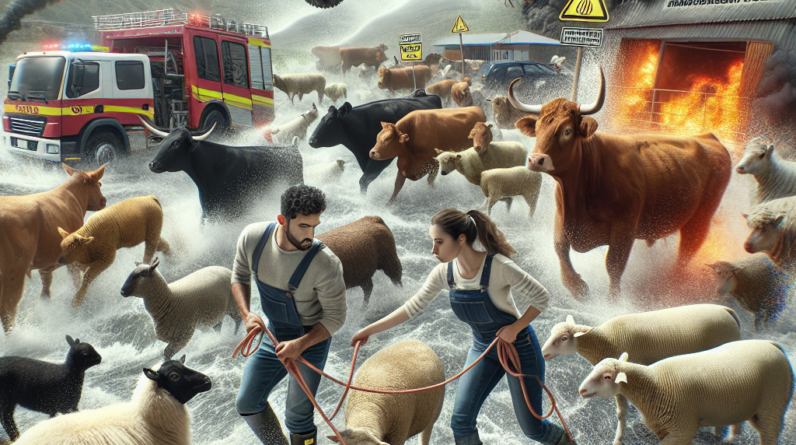
Ensuring the safety and well-being of livestock during disasters is critical for any farm manager or livestock owner. Proper planning not only secures your animals but also minimizes economic losses and stress for both you and your animals. Here’s a comprehensive guide on how to effectively prepare for and manage disaster situations affecting livestock.
Prepare an Emergency Plan
# Assess Risks and Identify Needs
When considering disaster preparedness for livestock, it’s vital to assess the specific risks associated with your geographical location. Floods, wildfires, and severe storms might pose different threats depending on where your farm is situated. Compile a list of potential hazards specific to your area to prioritize which livestock and parts of your property are most at risk.
After identifying the risks, evaluate the specific needs of your livestock during a disaster. Determine the quantity of food and water required and consider any special health needs they may have. Allocating resources effectively and storing extra food and medication in safe, accessible places is crucial.
It’s also important to communicate your emergency plan with your family and farm workers. Ensuring everyone knows their roles and where to find essential resources can prevent confusion and panic during an emergency.
# Create a Shelter Plan
Establishing a robust shelter plan is akin to setting up a safety net for your livestock. Depending on the nature of the disaster, you may need to relocate animals swiftly. Pre-identifying safe relocation sites can greatly ease this process.
When planning shelters, focus on the durability and safety of the materials used. Strong, well-ventilated shelters are necessary to protect your livestock from harsh conditions. Always keep essential tools like halters and leads readily available for quick evacuations.
# Practice Drills
Conducting regular practice drills can significantly enhance the readiness of both humans and animals during real disasters. These drills should include walking through evacuation routes and roles, ensuring everyone is familiar with the procedures.
Maintain a calm and positive atmosphere during drills; animals are sensitive to human emotions and a calm demeanor helps reduce their stress. Involve all potential helpers in these drills to ensure smooth execution during actual emergencies.
Stockpile Resources
# Gather Necessary Supplies
Before disaster strikes, stockpiling essential supplies such as feed, water, medications, and first-aid kits is advisable. Use storage containers that allow easy access to these items and maintain a regular inventory to avoid shortages.
Also, consider storing additional emergency items like flashlights, batteries, tools, and portable fencing in safe, elevated locations if flooding is a risk.
# Water Management
Ensuring a reliable supply of clean water is critical for the survival of livestock during disasters. Set up systems to secure and store water safely and consider portable tanks for evacuation scenarios.
Regularly monitor your water sources, particularly before expected adverse weather, to ensure your animals have access to clean water at all times.
# Feed Storage and Rotation
Keep a sufficient stockpile of feed, stored in a cool, dry place to prevent spoilage. Implement a feed rotation system to use older supplies first and consider alternative feed sources like forage or fodder.
Secure your feeding areas from potential threats such as rodents or other pests to ensure your supplies remain intact and accessible during emergencies.
Make a Communication Plan
# Stay Informed about Weather Conditions
Being well-informed about upcoming weather conditions can drastically affect your disaster preparedness. Utilize local news outlets, weather apps, and community networks to receive timely updates.
Share critical weather information with neighbors and the wider farming community to aid collective preparedness. Social media and community forums are also valuable for exchanging tips and experiences related to disaster management.
# Establish Contact Points
Compile a list of emergency contacts including veterinarians, supply vendors, and local farmers. This network will enable quick access to necessary services and support during a crisis.
Communicate your plans with this network to ensure everyone knows how to coordinate and assist during emergencies. Technology such as group messaging apps and social media can enhance communication efficiency.
# Use Technology to Your Advantage
Incorporate technology to monitor livestock behavior and receive alerts on potential hazards. Investing in such tools can offer peace of mind and significantly improve your disaster response capabilities.
Develop a Recovery Plan
# Assess Damage and Needs Post-Disaster
Following a disaster, promptly check the welfare of your livestock and evaluate property damage. Use a structured checklist to guide your assessment and prioritize recovery actions.
Reach out for support from experts or neighbors if needed. Sometimes, additional help can provide a fresh perspective and assist in identifying issues that might have been overlooked.
# Rebuild Resources
After assessing the damage, focus on rebuilding your resources. Contact local agricultural organizations for possible assistance or grants available for livestock recovery.
Reevaluate and restock your emergency supplies and tools, learning from past experiences to better prepare for future incidents.
# Implement Lessons Learned
Reflect on the effectiveness of your disaster response and identify areas for improvement. Keep a record of lessons learned to continually refine your disaster management plan.
Share your experiences and insights with the community to collectively enhance disaster readiness and response capabilities.
Stay Engaged with the Community
# Join Local Agricultural Groups
Active participation in local agricultural groups can provide support, resources, and valuable information specific to disaster preparedness in your area. These groups offer a platform to exchange knowledge and foster community bonds.
# Participate in Training Workshops
Engage in local training workshops to stay updated on the latest best practices and innovative approaches to disaster management. These workshops are also excellent opportunities for networking and sharing experiences.
# Encourage Community Involvement
Promote community involvement in disaster preparedness through meetings, preparedness days, and shared resources. Building a culture of preparedness within the community enhances overall resilience and support.
FAQs
# 1. Why is it important to prepare an emergency plan for livestock?
An emergency plan is essential as it outlines specific strategies and procedures to follow during disasters, ensuring the safety and well-being of your livestock and reducing stress for everyone involved.
# 2. What resources should I stockpile for livestock emergencies?
Essential resources to stockpile include feed, water, medications, and basic first-aid supplies to ensure your livestock have what they need during a crisis.
# 3. How can I stay informed about potential disasters?
Stay informed by utilizing local news services, weather apps, and maintaining communication with your community through platforms like group chats and social media.
# 4. What should I do immediately after a disaster strikes?
First, assess the health and safety of your livestock, then check for and address property damage. Prioritize actions to stabilize your operation as quickly as possible.
# 5. How can community involvement improve disaster preparedness?
Community involvement fosters a supportive network where resources, knowledge, and assistance are shared, enhancing the collective ability to manage and recover from disasters.


